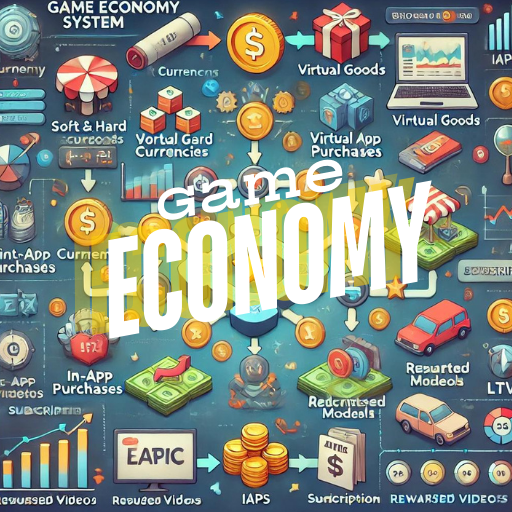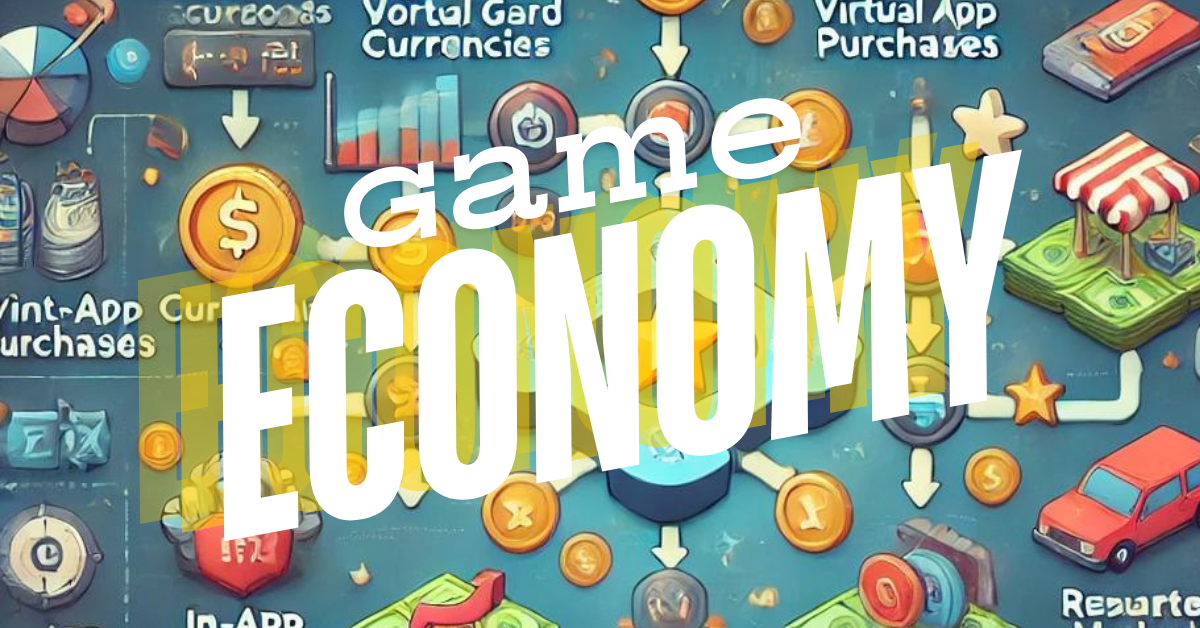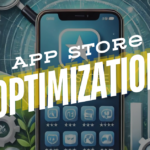
Creating a game economy that drives revenue involves strategic planning, balancing in-game currencies, virtual items, and monetization methods to enhance user engagement and encourage spending. Here’s a structured approach to designing a game economy:
1. Understand Your Game’s Genre and Audience
- Audience behavior: Analyze how players engage with games similar to yours. Hardcore vs. casual players have different spending patterns.
- Game design: Build a game loop that naturally encourages spending without feeling forced or pay-to-win.
2. Core Elements of a Game Economy
- Currencies: Introduce both soft (earned through gameplay) and hard currencies (purchased with real money). Balance these currencies to give players a reason to engage with both systems.
- Resource management: Consider the scarcity of resources or items that players can buy or earn, adding layers of strategy to the game.
- Progression systems: Use experience points, levels, or unlockables that can be accelerated via spending.
3. Virtual Goods and Pricing
- Tiered items: Offer items at different price points to cater to a wide range of players (from casual players to whales).
- Cosmetics vs. Functional items: Cosmetic items (skins, avatars) can generate revenue without impacting game balance, while functional items (weapons, boosts) should be handled carefully to avoid imbalance.
- Limited-time offers and events: Special events, flash sales, or seasonal content can encourage players to spend during specific windows.
4. Monetization Strategies
- In-app purchases (IAPs): Sell virtual goods, premium currencies, or boosters. Offer discounts or bundles to increase the perceived value.
- Ads: Implement rewarded video ads that give users small rewards for watching, like extra lives or in-game currency.
- Subscriptions: Create a subscription service for regular players, offering exclusive rewards or currency on a daily or weekly basis.
- Gacha/loot boxes: A random reward system where players spend to get a chance for rare items. Ensure transparency to avoid backlash.
5. Player Engagement and Retention
- Reward loops: Create a loop where users feel rewarded frequently, which builds engagement and loyalty.
- Daily missions and rewards: Encourage daily logins and engagement by offering rewards for regular play, driving more opportunities for spending.
- FOMO (Fear of Missing Out): Use scarcity, like limited-time items or seasonal events, to create urgency around spending.
6. Data-Driven Optimization
- Track player behavior: Use analytics to see where users drop off or spend most. Adjust the economy based on how different player segments interact with the game.
- A/B testing: Regularly test new items, currencies, and pricing structures to optimize spending without alienating players.
7. Balancing the Economy
- Inflation control: Ensure that in-game resources and currency don’t become too abundant. Players won’t spend real money if items become too easy to obtain.
- Player progression: Ensure the game doesn’t feel pay-to-win, especially for competitive games. Maintain a balance between paid and free players to retain the player base.
8. Community Feedback
- Actively gather feedback from players to understand their frustrations and desires. This will help you iterate on the economy without losing player trust.
Let’s delve deeper into each aspect of creating a game economy that effectively drives revenue. We’ll explore strategies, best practices, and actionable insights to help you design a robust and engaging game economy.
1. Understand Your Game’s Genre and Audience
a. Audience Segmentation
- Identify Player Types: Segment your players into categories such as casual, hardcore, competitive, social, etc. Understanding these segments helps tailor the economy to meet diverse needs.
- Behavior Analysis: Use analytics tools to study player behavior patterns—how they progress, where they spend time, and where they drop off.
- Persona Development: Create detailed player personas to visualize and empathize with your target audience, aiding in designing features that resonate with them.
b. Genre-Specific Dynamics
- Competitive Games: Focus on balanced monetization that doesn’t create pay-to-win scenarios. Emphasize cosmetic items or quality-of-life improvements.
- Casual Games: Leverage simple and intuitive monetization methods like ad-based rewards or small in-app purchases that enhance the casual experience.
- Strategy/RPG Games: Implement complex economies with multiple currencies, resource management, and progression systems that encourage long-term engagement.
c. Cultural Considerations
- Global Audience: If your game targets a global market, consider cultural preferences and spending behaviors across different regions.
- Localization: Adapt pricing, currency types, and promotional strategies to fit local markets, enhancing relatability and willingness to spend.
2. Core Elements of a Game Economy
a. Currencies
- Soft Currency:
- Earning Mechanisms: Typically earned through gameplay, such as completing levels, quests, or achievements.
- Usage: Used for common purchases like basic items, upgrades, or entry fees for certain activities.
- Balance: Ensure soft currency is sufficiently attainable to keep players engaged without diminishing its value.
- Hard Currency:
- Acquisition: Purchased with real money or earned through significant achievements/events.
- Usage: Reserved for premium items, exclusive content, or time-saving options.
- Scarcity: Maintain a sense of scarcity to enhance perceived value and encourage spending.
b. Resource Management
- Scarcity and Abundance:
- Scarce Resources: Create demand by limiting availability, encouraging strategic use or purchases.
- Abundant Resources: Ensure essential gameplay elements are accessible to prevent frustration.
- Resource Flow:
- Inflows: How players acquire resources (e.g., missions, rewards, purchases).
- Outflows: How players spend resources (e.g., items, upgrades, customization).
- Balancing Act: Monitor and adjust the rate of resource inflow and outflow to maintain equilibrium and prevent inflation or deflation.
c. Progression Systems
- Experience Points (XP) and Levels:
- Scaling Challenges: Ensure that progression scales with player skill and engagement.
- Rewards: Offer meaningful rewards at each level to motivate continued play and spending.
- Unlockables:
- Tiered Unlocks: Design a tiered system where higher tiers offer more valuable or exclusive content.
- Achievement-Based: Tie unlocks to specific achievements to incentivize diverse gameplay.
3. Virtual Goods and Pricing
a. Tiered Items
- Diverse Price Points:
- Entry-Level Items: Affordable options for casual spenders.
- Mid-Tier Items: Moderate prices for more engaged players.
- Premium Items: High-priced items targeting ‘whales’—players willing to spend significantly.
- Value Proposition: Clearly communicate the benefits and uniqueness of each tier to justify pricing.
b. Cosmetics vs. Functional Items
- Cosmetic Items:
- Non-Intrusive: Enhance personalization without affecting gameplay balance.
- High Demand: Often favored by players who want to stand out or express themselves.
- Functional Items:
- Balanced Impact: Provide advantages without making non-paying players feel disadvantaged.
- Strategic Use: Encourage spending by offering convenience or efficiency rather than direct power boosts.
c. Limited-Time Offers and Events
- Scarcity Marketing:
- Time-Limited Items: Create urgency by making items available only for a short period.
- Exclusive Events: Host events that offer unique rewards, fostering a sense of community and participation.
- Seasonal Content:
- Themes: Align offers with seasons, holidays, or cultural events to stay relevant and engaging.
- Recurring Opportunities: Implement regular events to maintain ongoing interest and spending opportunities.
d. Pricing Strategies
- Psychological Pricing:
- Charm Pricing: Use prices ending in .99 to make items appear cheaper (e.g., $4.99 instead of $5).
- Anchoring: Present higher-priced items first to make subsequent options seem more affordable.
- Bundle Pricing:
- Value Packs: Offer bundles that provide more value than individual purchases, encouraging higher spending.
- Themed Bundles: Group related items together to increase their appeal and coherence.
4. Monetization Strategies
a. In-app purchases (IAPs)
- Consumables:
- Usage: Items like health packs, energy boosts, or temporary power-ups.
- Frequency: Ensure consumables are replenishable to encourage repeat purchases.
- Non-Consumables:
- Permanent Ownership: Items like cosmetic skins, levels, or character slots.
- One-Time Purchase: Once bought, these items remain available to the player indefinitely.
- Premium Currency:
- Multipurpose Use: Allow players to use premium currency across various purchases, increasing its utility and value.
b. Advertisements
- Rewarded Video Ads:
- Incentivized Viewing: Offer players rewards (e.g., extra lives, in-game currency) for watching ads.
- User Control: Let players choose when to watch ads to maintain a positive user experience.
- Interstitial Ads:
- Strategic Placement: Display ads at natural transition points (e.g., between levels) to minimize disruption.
- Banner Ads:
- Subtle Integration: Place banners in non-intrusive areas to generate passive revenue without affecting gameplay.
c. Subscriptions
- Subscription Tiers:
- Basic to Premium: Offer multiple subscription levels with escalating benefits.
- Exclusive Content: Provide subscribers with unique items, currencies, or access to special events.
- Recurring Revenue:
- Consistent Income: Ensure that subscriptions offer ongoing value to maintain long-term commitments.
- Trial Periods:
- Free Trials: Allow players to experience subscription benefits before committing, increasing conversion rates.
d. Gacha/Loot Boxes
- Randomized Rewards:
- Variety and Surprise: Offer a wide range of possible rewards to create excitement and anticipation.
- Rarity Tiers: Categorize items by rarity to encourage attempts for rare, high-value items.
- Transparency and Fairness:
- Probability Disclosure: Clearly communicate the chances of obtaining different rarity items to build trust.
- Regulatory Compliance: Ensure your gacha system complies with regional laws and regulations to avoid legal issues.
e. Hybrid Models
- Combining Strategies:
- IAP + Ads: Offer players the choice between spending money or watching ads for the same reward.
- Subscriptions + IAPs: Provide subscribers with exclusive IAP discounts or bonus content.
5. Player Engagement and Retention
a. Reward Loops
- Frequent Rewards:
- Small, Regular Rewards: Keep players motivated with consistent, achievable rewards.
- Milestone Rewards: Offer significant rewards at key progression points to maintain long-term interest.
- Variable Rewards:
- Randomized Rewards: Introduce unpredictability in rewards to keep players engaged and eager to continue playing.
b. Daily Missions and Rewards
- Daily Login Bonuses:
- Consistency Incentive: Encourage daily engagement by offering increasing rewards for consecutive logins.
- Daily Challenges:
- Short-Term Goals: Provide tasks that can be completed within a day, offering rewards upon completion.
- Streak Rewards:
- Extended Engagement: Reward players for maintaining daily activity over extended periods (e.g., weekly streaks).
c. FOMO (Fear of Missing Out)
- Scarcity and Urgency:
- Limited-Time Items: Release exclusive items available only for a short duration.
- Countdown Timers: Display timers on limited-time offers to create a sense of urgency.
- Exclusive Content:
- Members-Only Items: Offer items that are only accessible through certain actions or during specific events.
- Social Proof:
- Leaderboards and Rankings: Show player standings to motivate others to participate and spend to improve their ranks.
d. Social Features
- Friend Systems:
- Invitations and Referrals: Encourage players to invite friends, offering rewards for both parties.
- Guilds or Clans:
- Community Building: Foster a sense of community where players can collaborate and compete together.
- Social Sharing:
- Content Sharing: Allow players to share achievements, milestones, or in-game content on social media platforms.
6. Data-Driven Optimization
a. Analytics Implementation
- Tracking Tools:
- Firebase Analytics, Unity Analytics, etc.: Use robust analytics platforms to gather comprehensive data.
- Key Metrics:
- ARPU (Average Revenue Per User): Measures the average revenue generated per player.
- LTV (Lifetime Value): Estimates the total revenue a player will generate over their entire engagement with the game.
- Retention Rates: Tracks how many players return after their first play, Day 1, Day 7, Day 30, etc.
b. Player Segmentation
- Behavioral Segments:
- High Spenders vs. Low Spenders: Identify and analyze the behaviors of different spending groups.
- Engagement Levels: Segment players based on how frequently and how long they play.
- Personalized Offers:
- Targeted Promotions: Tailor offers and incentives based on player segments to maximize conversion rates.
c. A/B Testing
- Experimentation:
- Feature Testing: Test different versions of features (e.g., pricing, item availability) to see which performs better.
- UI/UX Changes: Assess how changes in the user interface impact player behavior and spending.
- Iterative Improvements:
- Data-Driven Decisions: Use test results to make informed adjustments to the game economy.
- Continuous Optimization: Regularly conduct A/B tests to keep refining and enhancing the economy.
d. Funnel Analysis
- Conversion Funnels:
- Identify Drop-Off Points: Analyze where players abandon the purchasing process and address those issues.
- Optimize Steps: Streamline the purchasing flow to reduce friction and increase conversion rates.
- User Journey Mapping:
- Understand Player Paths: Map out common pathways players take within the game to identify monetization opportunities.
e. Predictive Analytics
- Forecasting:
- Player Behavior Prediction: Use machine learning models to predict future player actions and spending habits.
- Revenue Forecasting: Estimate future revenue based on current trends and player data.
- Proactive Adjustments:
- Preemptive Balancing: Adjust the game economy based on predicted changes in player behavior to maintain balance and engagement.
7. Balancing the Economy
a. Inflation Control
- Resource Allocation:
- Controlled Distribution: Limit the amount of in-game currency and resources players can earn over time.
- Sinks and Faucets:
- Sinks: Implement ways for players to spend or lose currency (e.g., upgrades, repairs) to remove excess from the economy.
- Faucets: Manage the rate at which currency enters the economy to prevent oversupply.
b. Dynamic Pricing
- Adjustable Prices:
- Based on Demand: Modify prices of items based on their popularity and demand.
- Event-Based Pricing: Offer discounts or premium pricing during special events to influence spending behavior.
- Elastic Pricing Models:
- Value-Based Pricing: Set prices based on the perceived value to the player rather than fixed costs.
- Psychological Adjustments: Use pricing strategies that align with player psychology to maximize sales.
c. Player Progression Balance
- Non-Pay-to-Win Design:
- Fair Progression: Ensure that players who spend money do not gain unfair advantages over non-paying players.
- Skill-Based Progression: Allow player skill and strategy to play a significant role in progression and success.
- Balanced Rewards:
- Equitable Benefits: Design rewards that benefit paying players without alienating free players.
- Optional Enhancements: Offer enhancements that are desirable but not essential for enjoying or progressing in the game.
d. Scaling Challenges
- Adaptive Difficulty:
- Dynamic Scaling: Adjust game difficulty based on player progression to maintain engagement without causing frustration.
- Content Updates:
- Regular Additions: Introduce new content, challenges, and items to keep the economy fresh and engaging.
- Balancing Updates:
- Ongoing Adjustments: Continuously monitor and tweak the economy based on player feedback and data to maintain balance.
8. Community Feedback
a. Feedback Channels
- In-Game Surveys:
- Quick Polls: Implement short surveys to gather immediate feedback on specific features or changes.
- Forums and Social Media:
- Community Platforms: Use forums, Discord servers, Reddit, and social media to engage with players and collect feedback.
- Direct Support:
- Customer Support: Encourage players to reach out with feedback, suggestions, and concerns through support channels.
b. Listening and Responding
- Active Listening:
- Monitor Feedback: Regularly review feedback from all channels to identify common themes and issues.
- Transparent Communication:
- Updates and Patches: Inform the community about upcoming changes and fixes and how their feedback is being addressed.
- Implementing Changes:
- Responsive Development: Prioritize and implement changes based on player feedback to show that their opinions matter.
c. Community Involvement
- Beta Testing:
- Early Access: Allow dedicated players to test new features or changes before full implementation, gathering valuable feedback.
- Feedback Incentives:
- Rewards for Input: Offer in-game rewards or recognition to players who provide constructive feedback.
- Community Events:
- Engagement Opportunities: Host events encouraging community participation and feedback, fostering a sense of ownership and loyalty.
d. Iterative Design
- Continuous Improvement:
- Regular Updates: Use feedback to make iterative improvements to the game economy and overall game experience.
- Flexible Design:
- Adaptability: Design the economy with flexibility in mind, allowing for adjustments based on player needs and market trends.
Additional Considerations
a. Ethical Monetization
- Fair Practices:
- Avoid Exploitation: Ensure monetization methods do not exploit players, particularly vulnerable groups.
- Transparency:
- Clear Communication: Be upfront about costs, odds (in the case of gacha), and the nature of in-app purchases to build trust.
- Compliance:
- Legal Standards: Adhere to regional laws and regulations regarding in-app purchases, data privacy, and advertising.
b. Cross-Platform Consistency
- Unified Economy:
- Consistent Pricing and Availability: Ensure that the game economy remains consistent across different platforms (iOS, Android, web) to prevent player frustration.
- Platform-Specific Features:
- Leverage Unique Capabilities: Utilize platform-specific features (e.g., Apple’s App Store promotions, Google Play’s subscription models) to enhance monetization strategies.
c. Competitive Analysis
- Benchmarking:
- Analyze Competitors: Study successful games in your genre to understand their monetization strategies and economic structures.
- Differentiation:
- Unique Selling Points: Identify opportunities to differentiate your game economy, offering unique value propositions that set your game apart.
d. Long-Term Vision
- Sustainable Growth:
- Scalable Economy: Design an economy that can grow and evolve with your game, accommodating new content and player bases.
- Future-Proofing:
- Anticipate Trends: Stay informed about industry trends and emerging monetization methods to keep your game economy relevant and competitive.
Conclusion
Designing a game economy that drives revenue is a multifaceted endeavor that requires a deep understanding of your audience, strategic planning, continuous optimization, and active community engagement. By carefully balancing in-game currencies, virtual goods, monetization strategies, and player retention tactics, you can create an engaging and profitable game experience. Leveraging data-driven insights and maintaining flexibility to adapt to player feedback and market changes will further enhance the effectiveness of your game economy.
Learn more about Crafting your strategy for ad monetization


